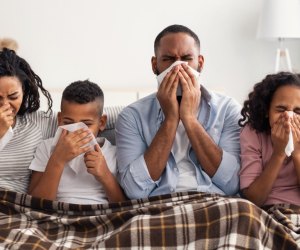Summer Safety Toolkit: How to Keep Kids Safe From Ticks, Drowning, and More

Kids and parents alike look forward to the carefree days of summer, but it’s also a time when activity-related accidents and injuries in children tend to rise. With families gearing up for backyard BBQs and beach vacations, we teamed up with Connecticut Children’s–the only health system 100% dedicated to kids–to share their 2022 Summer Safety toolkit.
In the toolkit, Connecticut Childrens’ experienced pediatric experts provide parents with everything they need to know about the most common summer safety concerns, at home or on your summer travels. From ticks and sunburn to dehydration and drowning, you’ll learn safety and prevention tips, plus when it’s time to call a doctor or visit the emergency room.
In this article we’re highlighting the top six summer safety tips for kids and families. Click through to the Connecticut Children’s website to see the full toolkit or explore their other children’s health and safety resources.
Drowning and Water Safety
Drownings are the most common cause of accidental death for children in the summer, so it’s an important time to brush up on water safety. Being a “water watcher” is one of the best things you can do for your kids this summer. That means paying close attention to young children anytime you’re near water, eliminating distractions like phones and alcohol, and taking turns with other adults to ensure constant supervision. Getting trained in CPR or learning basic water rescue skills are also important ways to be sure you’re prepared for a life-threatening emergency.
For added protection, enroll your kids in swim lessons and put them in certified life jackets when visiting the beach or any home with a pool. Teach water safety rules young and discuss them often.
Ticks and Tick-Borne Disease
Unfortunately, late spring and early summer are prime time for ticks. And your kids are most likely to come into contact with them in wooded areas, tall grass, or lawn cuttings and leaf piles. Your first defense is putting children in the right clothing–light-colored long-sleeve shirts, pants tucked into high socks, closed-toe shoes, and hats. Your next line of defense is tick repellant, which can come in the form of DEET or Permethrin. Just make sure to use an age-appropriate product and apply it as directed. If you’re unsure, ask your pediatrician.
Perform a tick check every time your kids come inside and bathe them within 2 hours. If you find a tick, carefully remove it with tweezers or the edge of a credit card, clean the bite area, and safely dispose of the tick. Unless the tick has likely been attached for 36 hours or more, there’s no need to contact your pediatrician. If you believe the tick has been attached for an extended period of time, reach out to your doctor and find out if your child needs antibiotics or an exam.
Dehydration
Kids get dehydrated surprisingly quickly because they lose more water through their skin when they sweat, compared to adults. Of course, keeping kids well-hydrated can also be a challenge because not all children are big on drinking water.
If you’re struggling to get your kids to gulp down the recommended 7-14 cups a day, try letting them decorate their water bottles with waterproof stickers and permanent markers, or add frozen fruits or a splash of juice to their water for a little added flavor. You can also focus on water-rich foods to supplement water intake throughout the day. Kick off the morning with a smoothie, pack juicy fruits and vegetables like watermelon and cucumber as snacks, or make yogurt-based popsicles as a hydrating treat.
Heat-Related Illness
If the forecast is showing 75% humidity on a hot day or the heat index is 90 degrees or higher, it’s time to keep outdoor play to a minimum to help prevent heat-related illness. If you are planning to spend time outside, avoid direct sun exposure during 10 am and 2 pm, offer lots of water and hydrating foods, and check in with your kids periodically to see how they’re feeling (plus, ensure that their teachers, counselors, or other caregivers are doing the same).
Get familiar with the signs of heat exhaustion and heat stroke, which can include fever, confusion, nausea and vomiting, and fatigue. When in doubt, do not hesitate to call your doctor to take your child to the emergency room. ERs are very well equipped to help cool your kid down and administer IV fluids as needed. With these treatments, most children will recover quickly.
Sunburn and Sun Protection
Again, it’s that 10 am to 2 pm window where you want to be extra mindful of sun exposure to steer clear of sunburn. If you’re outside, seek shade and make sure to apply broad spectrum sunscreen with an SPF of 30 or higher. Aim to put on sunscreen 20-30 minutes before exposure and reapply every two hours. Lightweight long sleeve shirts or rashguards and wide-brim hats are also meaningful ways to protect your skin–especially in kids under 6 months who may not be able to wear sunscreen.
If your child does get a sunburn, a cool bath can be really soothing. You can also ask your pediatrician if it’s safe to apply aloe or give pain medication, like acetaminophen or ibuprofen. If your child is under one or has fever or blistering, it’s also best to call your doctor for guidance.
COVID-19 and Travel
COVID-19 is still a concern for many families as they make summer plans. If you have a little one who’s too young to be vaccinated, the CDC recommends you use caution when traveling and have your child wear a mask indoors where community spread levels are high.
When planning a vacation, consider your child’s risk factors–namely any health conditions that might put them at risk for severe illness from COVID-19. Also, research your destination to find out what community spread looks like, and think about how you’ll actually get there. Will you be taking the family car? Or will you need to get on two connecting flights, which could mean more exposure? You might also consider where you’ll be staying on the trip and what activities you’ll want to participate in.
Lastly, your own comfort level is an important factor in travel decisions right now. Think about your risk tolerance and whether taking an adventure with the proper precautions feels like a fit for your family, or if you’d feel more confident waiting until your child is vaccinated. Fortunately, it looks like vaccines for ages 5 and under are on the way, so you may not have too long to wait!
For more timely health and safety tips, check out Connecticut Children's latest resource kit for families, the 2022 Summer Safety Kit. Connecticut Children’s is ranked one of the best children’s hospitals in the nation by U.S. News & World Report and is a Magnet® designated hospital. It provides more than 30 pediatric specialties, conveniently delivered at locations close to home and by Video Visit.
The contents of this article are for informational purposes only and not intended to be a substitute for professional medical advice, diagnosis, or treatment. Always seek the advice of your physician or other qualified health provider with any questions you may have regarding a medical condition.
























































